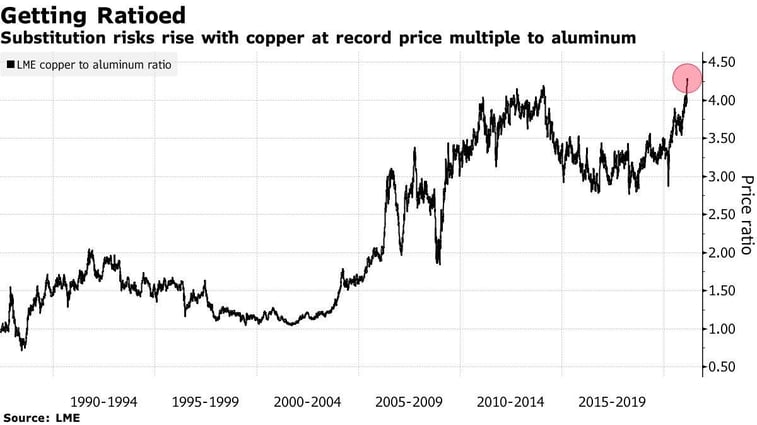A principle goal of value engineering is to deliver long-term performance and reliability at the lowest cost practicable. One effective way to reduce the levelized cost of energy (LCOE) in large-scale or commercial and industrial (C&I) solar applications is to strategically substitute less-expensive aluminum conductors in place of more expensive copper conductors.
While not viable as a wholesale replacement for copper conductors, aluminum conductors are ideally suited for specific circuits in PV power plants. When specified and installed properly, aluminum conductors provide the same performance and reliability as copper—at a fraction of the cost. Utility system operators and electrical equipment manufacturers have long taken advantage of these cost savings opportunities. Savvy solar project developers and contractors are following suit.
Why Use Aluminum?
Aluminum is the most abundant metal in the earth’s crust. As such, aluminum is not only more affordable than copper, but also less susceptible to supply constraints and price volatility. As I write today, the commodity clearing price of copper is $9,202.51 per ton versus $2,389.06 per ton for aluminum, which is a copper-to-aluminum price ratio of 3.85:1. While commodity costs are variable, today’s price multiple for copper is generally consistent with the trend over the last decade or so. As noted in a recent Bloomberg article, the price premium for copper favors strategic substitution with aluminum.
 Courtesy Bloomberg
Courtesy Bloomberg
Aluminum is not only a fraction of the cost of copper, but also is twice as conductive as copper on a per-pound basis. Volumetrically, of course, copper is the more efficient conductor. Per unit of volume, aluminum has 62% of the electrical conductivity as compared to copper. For a given ampacity, this means that an aluminum conductor will have to be larger than a copper conductor.
Even after accounting for larger conductors and conduits, aluminum provides a meaningful opportunity for conductor cost savings. As we noted previously, the cost advantage of aluminum conductors actually increases at higher current levels and wire gauges.
Misconceptions About Aluminum Conductors
You may be asking yourself, “If aluminum is so cost-effective, why is it not more popular as an electrical conductor?” This perception does not reflect reality and is one of many misconceptions about aluminum conductors that are easily dispelled.
Myth #1: Aluminum is not widely used as a conductor material.
The highly reliable power transmission and distribution system that delivers electricity from power generators to our homes and businesses is wired almost exclusively using aluminum conductors. Electrical equipment manufacturers use aluminum for everything from transformer windings to panelboard busbars. Though the use of aluminum is not always readily apparent, it is in fact ubiquitous in electrical power systems. The use of aluminum as a conductor material has been codified since the 1901 edition of the National Electrical Code.
Myth #2: Aluminum conductors are not as safe or reliable as copper conductors.
Though this perception has some historical basis in fact, it is also further evidence that a misunderstanding can travel halfway around the world while the truth is still putting on its shoes. In the late 1960s and early 1970s, the use of aluminum branch circuits was publicly associated with poor in-field electrical performance. By and large, incident investigators ultimately determined that incompatible materials and installation errors were largely to blame for many of the early problems associated with aluminum conductors in buildings.
Early aluminum conductors also used a utility-grade aluminum alloy that is not ideally suited for use in building wires. Once identified as a deficiency, industry stakeholders developed new product safety standards for aluminum building wire. Since 1972, aluminum building wire has been constructed out of modern compact-stranded aluminum alloys that are equal to copper conductors in terms of safety and reliability. Product safety standards developed in the 1970s have also addressed terminal compatibility.
Myth #3: Aluminum conductors are not as strong as copper.
For the same cross-sectional area, aluminum does in fact have a lower tensile strength than copper. At the same time, a greater cross-section of aluminum is required to carry the same amount of current as copper. The net result is that a properly sized aluminum conductor is effectively as strong and durable as a copper conductor sized for the same ampacity. Moreover, aluminum conductors are more flexible than an equivalent copper conductor.
 Courtesy IAEI Magazine
Courtesy IAEI Magazine
What are the Best Uses for Aluminum in Solar Assets?
Typically, the low-hanging fruit for substituting aluminum conductors in place of copper conductors is on the AC side of a PV power system. Generally speaking, the electrical equipment used to aggregate AC circuits in a solar power plant will have dual-rated wire terminals, meaning the products are certified and listed for use with either copper or aluminum conductors. Moreover, AC aggregation circuits often require larger-diameter conductors, based on ampacity and voltage drop, which presents an ideal opportunity for cost savings.
The decision to use aluminum conductors on the DC side of a PV system is not as clear-cut. The cost difference between aluminum and copper is modest for smaller conductors, which limits the opportunity for cost savings. Therefore, Pure Power Engineering generally does not recommend using aluminum conductors smaller than #2 AWG. Moreover, many wiring terminals on the DC side of a PV system are not dual-rated by default, meaning that DC combiners may need to be specially ordered to accommodate the use of aluminum conductors.
Since aluminum PV wire is not as readily available as copper PV wire, aluminum conductors are not widely used within the PV array itself. Some project architectures, such as central inverter-based designs, call for the use of large-diameter DC feeders, which may represent an opportunity for strategic substitution. Provided that all terminations are compatible, aluminum DC feeder conductors are an option for circuits with conductors sized #2 AWG and larger.
If you are looking for more tips for lowering the LCOE on commercial- or utility-scale PV power systems without sacrificing reliability, contact Pure Power Engineering to learn more about our value-engineered design and construction drawing services.
.png)
